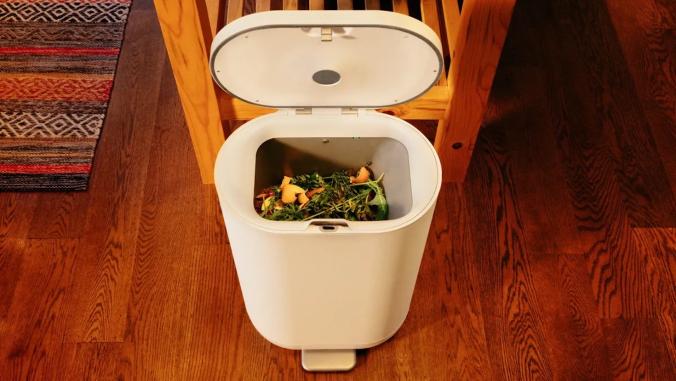Dutch company Kipster just entered the American grocery market with a compelling promise: producing sustainable and high-welfare eggs with a much lower price premium than comparable pasture-raised products.
Kipster is approaching its U.S. market expansion in partnership with MPS Egg Farms for production and Kroger for retail. The eggs were supposed to hit the shelves at the end of last year, but the construction of the four barns in North Manchester, Indiana, which house 24,000 hens and are expected to produce 28 million eggs per year, was only finished in August.
Still, it was a big deal for the Dutch innovator — even Queen Máxima of the Netherlands contributed a video message to the farm’s opening ceremony. "This is a step closer to a circular, truly sustainable agriculture," she said.
Designing new barns with animal welfare in mind and raising the chickens on upcycled feed are Kipster’s biggest distinguishing features. "Years of R&D went into it — a lot of time, money and stakeholder engagement," said Sandra Vijn, managing director of Kipster in the U.S.
A new kind of barn, based on chickens’ needs
The company designed an innovative environment that would speak to the birds’ needs and natural behaviors while allowing for high productivity. "Instead of just looking at the barn from an output perspective, we looked at it thinking about what a chicken actually needs. Spaces to climb, opportunities to forage and so on," Vijn said.
The result is a barn with lots of natural light and fresh air, tree-like wooden structures and outdoor space that’s protected from predators. Of course, it’s not a forest — chickens’ original habitat — but it’s a noticeable improvement to the dark, smelly, crowded and bleak conditions most of today’s farmed chickens have to endure.
Compared with other free-range farms, it doesn’t feature extensive pasture space. Kipster’s researchers observed that the birds stay close to barns or other protected areas even when they have lots of room to roam — because they want to be safe from predators and aren’t fans of rain and heat. So Kipster opted for a larger and better-designed indoor space that provides enrichment even in the winter and a smaller outdoor space.
As a result, Kipster doesn’t have to hide what it’s doing from customers. It welcomes farm visitors and even streams what’s going on via live webcams. Its birds also tend to be healthier and less likely to contract and spread the highly contagious bird flu that continues to ravage the world, according to Ben Williamson, U.S. executive director of Compassion in World Farming.
We don’t just give them any waste. It’s a time-intensive process that guarantees their needs are met for different life stages, productivity and health.
Finally, it’s notable that Kipster raises male chicks and spent hens for ethical reasons and tries to create new markets for these no-longer-typical meat products. As outlined in a WWF analysis, this approach improves animal welfare but comes with environmental trade-offs.
Slashing emissions with a circular feed supply chain
Kipster’s second major accomplishment is its upcycled feed supply chain. In the Netherlands, where the company has been operating since 2017, between 90 to 95 percent of what the chickens eat comes from a circular supply chain. The U.S. operations still have some catching up to do to establish the same structures and get from 65 percent upcycled feed to the same level.
"We don’t just give them any waste. It’s a time-intensive process that guarantees their needs are met for different life stages, productivity and health," said Vijn.
In collaboration with a feed mill in Ohio, nutritionists and veterinary teams, Kipster takes leftovers and byproducts from farms, bakeries and other food producers and processes them into feed pellets for the chickens. Grains sprinkled on the floor throughout the barns and alfalfa hayballs keep the chickens foraging throughout the day, providing an additional source of fiber and enrichment.

Drone shot of the chicken farm. Image courtesy of Kipster.
According to the company’s carbon footprinting calculations, the upcycling process halves its feed emissions. It significantly lowers the company’s overall emissions because 58 percent of Kipster’s total carbon footprint is from feed. Other carbon-reducing measures include installing solar panels on barn roofs and drying manure.
What’s more — these investments and innovations make business sense. Kipster is only six years old and already profitable. Its pricing is competitive, currently retailing at $4.99 for a case of 12 eggs at Kroger. With that, it comes in about halfway between Vital Farms’ pasture-raised organic eggs ($8.99) and Kroger’s cheapest conventional option ($1.29), making high-welfare and sustainable eggs an option for a broader range of consumers.
Carbon neutrality: A questionable sales pitch
Kipster is doing many things that make a difference for the birds and the environment and truly distinguish it from competitors. But in its marketing efforts, it leads with one of the more controversial claims — carbon neutrality.
The press release I received about the North Manchester farm opening was titled: "Celebrating ‘world’s first carbon-neutral eggs’ to the US." I almost deleted the email right away because most of the carbon-neutral product news I receive are mostly PR stunts. The egg carton also prominently features the slogan "carbon neutral eggs."
Because agriculture — and especially raising livestock — is a resource-intensive industry, I’m fairly skeptical about anyone who claims they’ve found a way to produce beef, eggs or other products without producing emissions. Usually, it means the company bought a bunch of offsets to make its products look better rather than coming up with innovative ways to reduce its emissions.
I have two concerns with this approach: First, carbon offsets don’t work well — so there’s a good chance the claim doesn’t hold up even if the company has calculated the product’s emissions correctly and bought enough offsets to compensate for them.
Second, it’s a confusing statement for consumers. Most will hear the claim — that beef or eggs are carbon neutral — without digging into how that came to be. This may encourage them to eat more beef and eggs rather than look into true alternatives such as plant-based foods.
Kipster’s reality lands somewhere in the middle. Their sustainability measures make them a lower-carbon option to many competitors, according to a WWF estimate. But its production isn’t carbon neutral — so its claim also hinges on offset purchases and can be misunderstood by consumers.






